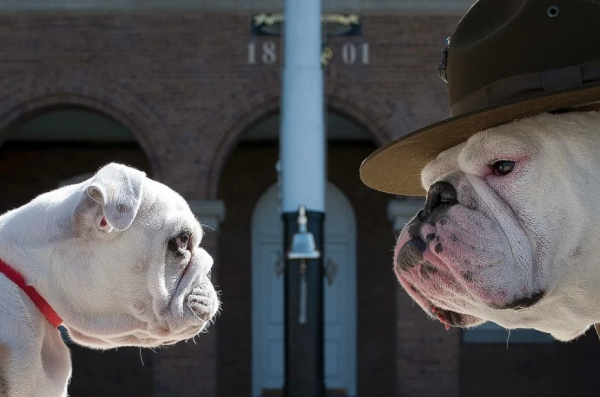
Today is the 245th birthday of the United States Marine Corps. Oorah!
The maritime/land service branch dates back to the Continental Marines formed by Captain Samuel Nicholas during the American Revolutionary War. A resolution to raise two battalions of Marines was passed by the Second Continental Congress on November 10, 1775, and ever since, this date is celebrated as the birthday of the Marine Corps.
The Marine Corps has had a long relationship with canines – most of which have been purebred dogs – and even their nickname is dog-related.
During an intense battle at Belleau Wood during WWI, the Germans called Marines Teufel Hunden for their fierce fighting  style; translated, it means “hell hounds,” though some translate it as devil dogs, and “devil dogs” is the name that stuck. The moniker appeared on recruiting posters in 1918 along with an image that depicted an English Bulldog wearing a US helmet chasing a Dachshund wearing a spiked German helmet. It announced the “Devil Dog Recruiting Station” address. They were very different times.
style; translated, it means “hell hounds,” though some translate it as devil dogs, and “devil dogs” is the name that stuck. The moniker appeared on recruiting posters in 1918 along with an image that depicted an English Bulldog wearing a US helmet chasing a Dachshund wearing a spiked German helmet. It announced the “Devil Dog Recruiting Station” address. They were very different times.
The Bulldog’s image and demeanor resonated with the Marines, and a relationship officially began in 1921 when Marines Marine Corps Commandant Brig. Gen. Smedley D. Butler purchased an English Bulldog named King Bulwark (later renamed “Jiggs”). Jiggs received a tailor-made set of dress blues and rank insignia, and his enlistment papers were signed in a formal ceremony. Sadly, Jiggs lived only five years before passing away. He died with the rank of Sergeant Major and was buried with full military honors at Quantico, Virginia.
Before Jiggs passed away, the mantle of Marine Corps mascot passed to Jiggs II (aka Silent White Richard), a champion made up at the Westminster Kennel Club Dog Show. He served as Marine Corps mascot for ten years and, after his passing death, he, too, was buried with full military honors at Quantico.
A string of Bulldogs, all named Chesty (in honor of the famous Marine, Lt. General Chesty Puller) followed. Some hung out at boot camps, and some were official mascots who served to boost morale, walk in parades, and witness ceremonies. The current mascot is Chesty XV who “enlisted” on March 19, 2018.
That Bulldogs are so closely associated with the Marine Corp may comes as a surprise to those who always thought that Doberman Pinschers were the USMC breed of choice. During WWII, the Marine Corps actually considered other breeds that included German Shepherd Dogs, Belgian Sheepdogs, Collies, Giant Schnauzers, Airedale Terriers, and Rottweilers, and for sledge and pack work, Malamutes, and Siberian Huskies. Still, it was Doberman Pinschers that were drafted into service as the official combat dog of the Marines during WWII. After training at Camp Lejeune’s Marine Corps War Dog Training Facility, the First Marine Dog Platoon made up of 48 enlisted handlers, twenty-one Dobermans and three German Shepherd Dogs was sent to serve in the Pacific Theater. The dogs guarded the men, of course, but they were also trained to explore island cave systems, detect landmines, and sound the alarm when necessary.
It was the first time an American armed service was deploying a large unit of dog teams in an organized tactical role. In all, sixty war dogs were deployed to Guam, and twenty-five of them died in action. Twenty more suffered injuries. There are few things more poignant than the War Dog Cemetery on Guam where a memorial pays tribute to the dogs who died during the Second Battle of Guam in 1944 (there’s an exact replica of the Guam memorial on the grounds of the University of Tennessee, too).
Did you know that at the National Archives at College Park, Maryland, there are eleven small boxes containing the individual Dog Record Books of each canine who enrolled in the Marine Corps from December 15, 1942, to August 15, 1945? Two more boxes hold the record books of another 132 dogs that were transferred from the Army into the corps. They tell the personal stories of these special canines during WWII, and it makes for sober reading, some of which you can see here.
